Quantitative Diagnoses and Comprehensive Evaluations of the Rationality of Chinese Urban Development Patterns
Abstract
:1. Introduction
2. Study Area and Data
3. Methods
3.1. Establishing a Comprehensive Diagnostic Indicator System for Urban Development Structure Rationality
| Target Layer | Sub-Target Layer | Factor Layer | Sub-Factor Layer |
|---|---|---|---|
| Urban Development Pattern Rationality Diagnosis | Urban scale structure rationality diagnosis | Urban system rationality | Zipf’s exponent |
| Urban scale efficiency rationality | Urban scale efficiency index | ||
| Urban spatial structure rationality diagnosis | Major function zoning | Major function zone carrying capacity index | |
| Degree of equilibrium of urban space | Urban distribution density index Urban space kernel density index | ||
| Urban functional structure rationality diagnosis | Functional scale | Benefits of scale index | |
| Functional strength | Specialization index | ||
| Specialized departments | Industry abundance index |
3.2. Comprehensive Diagnostic Model for Urban Development Structure Rationality
| Type/Weight/Criteria | USR | UKR | UFR | |||
|---|---|---|---|---|---|---|
| y1 = 0.3571 | y2 = 0.3286 | y3 = 0.3143 | ||||
| Criteria (USR value) | attribute value | Criteria (matrix) | attribute value | Criteria (UFR value) | attribute value | |
| Highly Rational City | USR > 0.64 | 5 | (A,a), (B,b), (C,c), (D,d) | 5 | UFR > 0.55 | 5 |
| Relatively Highly Rational City | 0.55 < USR < 0.63 | 4 | (A,b), (B,a), (D,c), (C,b) | 4 | 0.44 < UFR < 0.54 | 4 |
| Moderately Rational City | 0.47 < USR < 0.54 | 3 | (D,b), (C,a) | 3 | 0.34 < UFR < 0.43 | 3 |
| Relatively Irrational City | 0.37 < USR < 0.46 | 2 | (A,c), (B,c), (D,a) | 2 | 0.26 < UFR < 0.33 | 2 |
| Irrational City | USR < 0.36 | 1 | (A,d), (B,d), (C,d) | 1 | UFR < 0.26 | 1 |
3.2.1. Diagnostic Model for Urban Scale Structure Rationality Based on Zipf’s Exponent
3.2.2. Diagnostic Model for Urban Spatial Structure Rationality Based on KDE
3.2.3. Diagnostic Model for Urban Functional Structure Rationality Based on the Shannon-Weiner Index
4. Results
4.1. Rationality Diagnosis of Chinese Urban Scale Structure
4.1.1. Fractal and Rationality Analysis of the Urban System Scale Structure
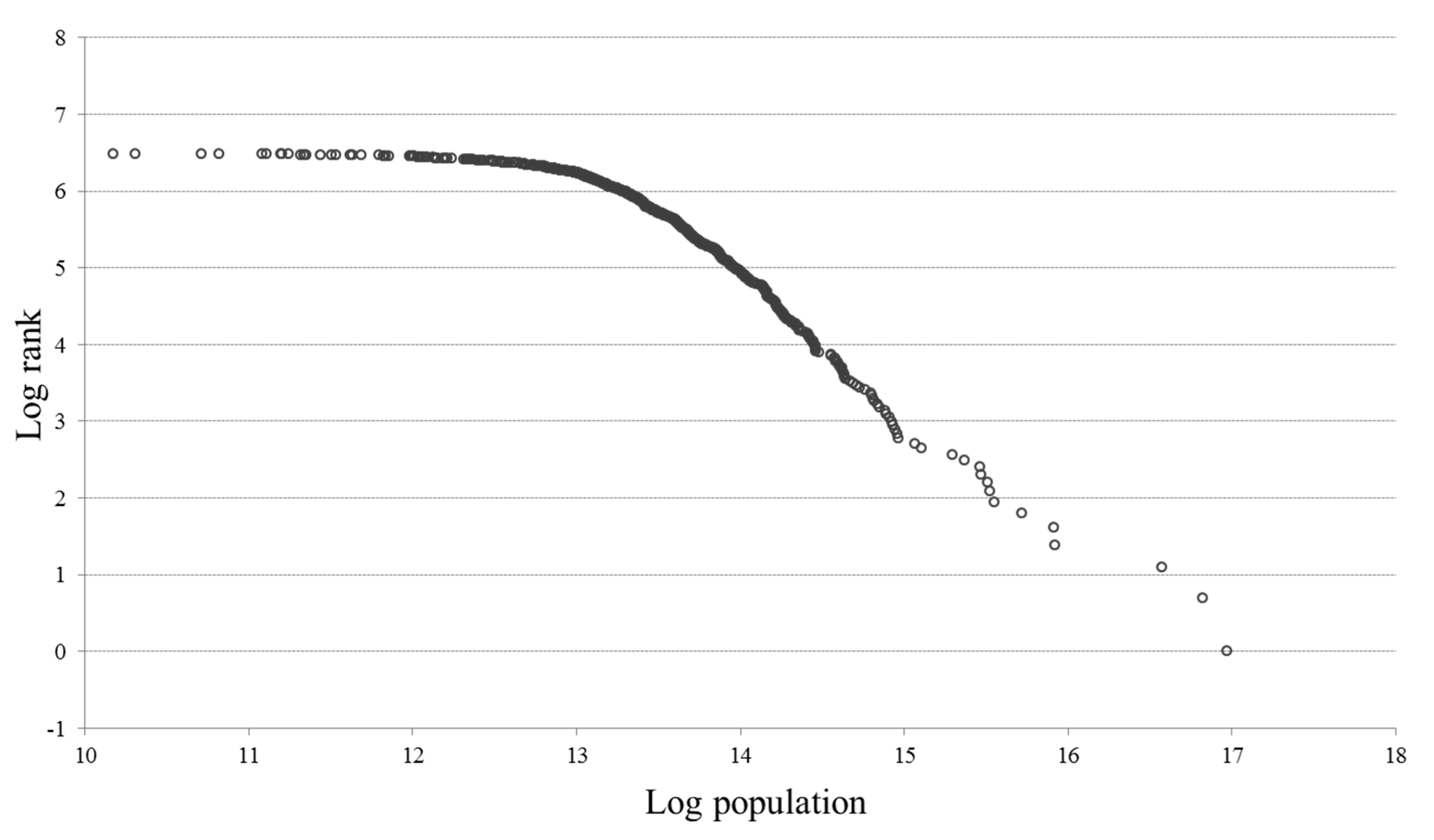
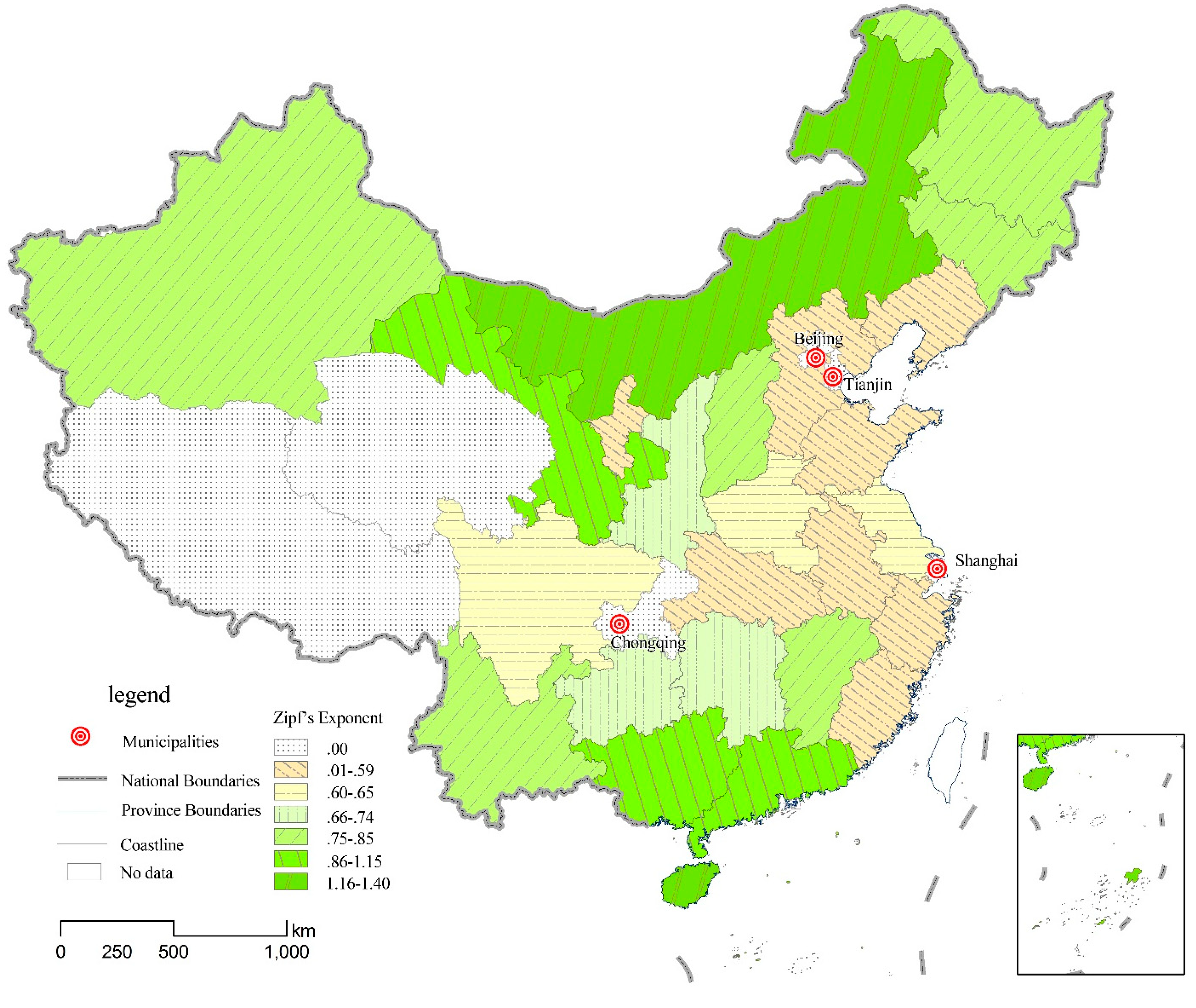

4.1.2. Rationality Analysis of Urban Scale Efficiency
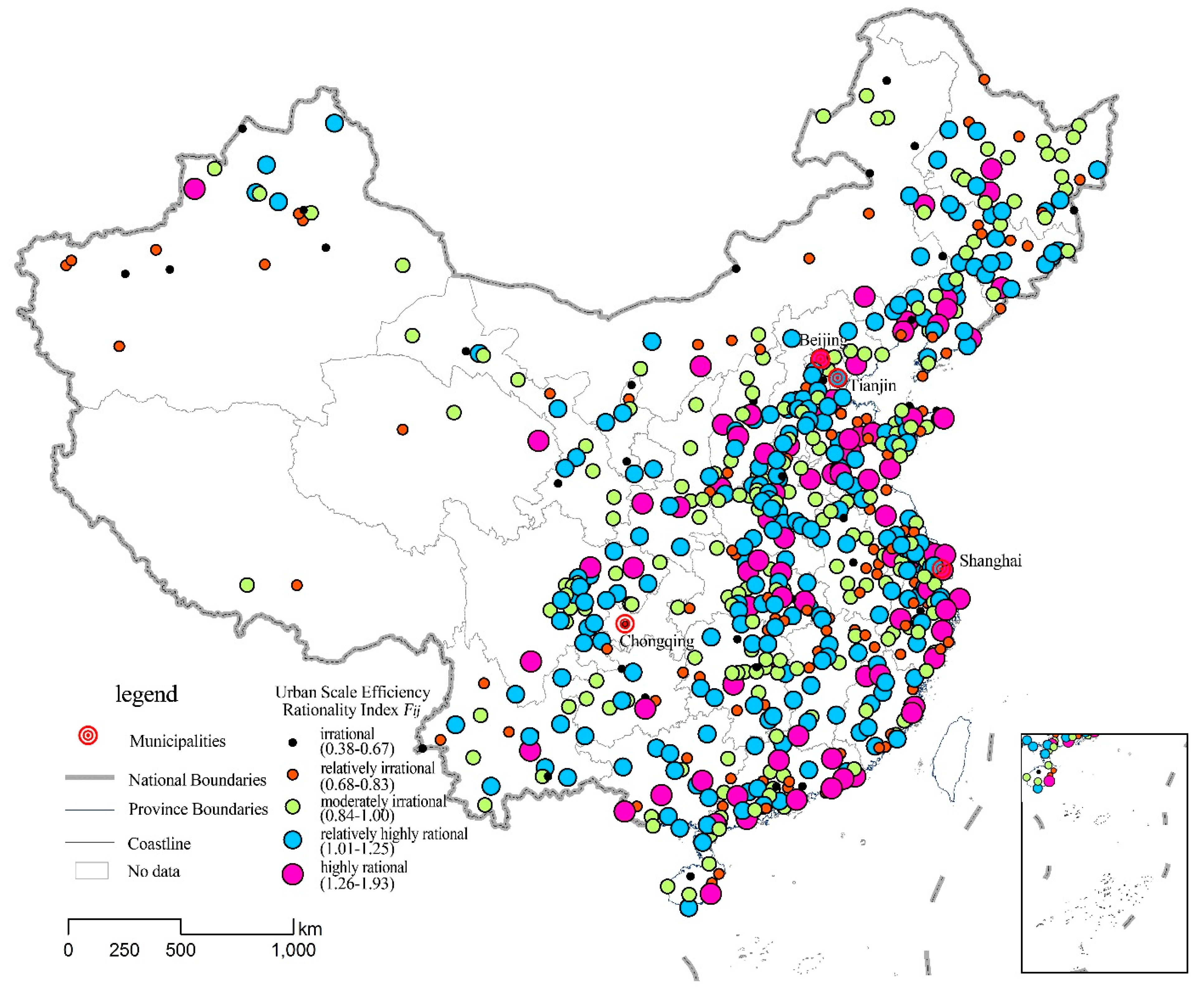
4.1.3. Urban Scale Structure Rationality Diagnosis
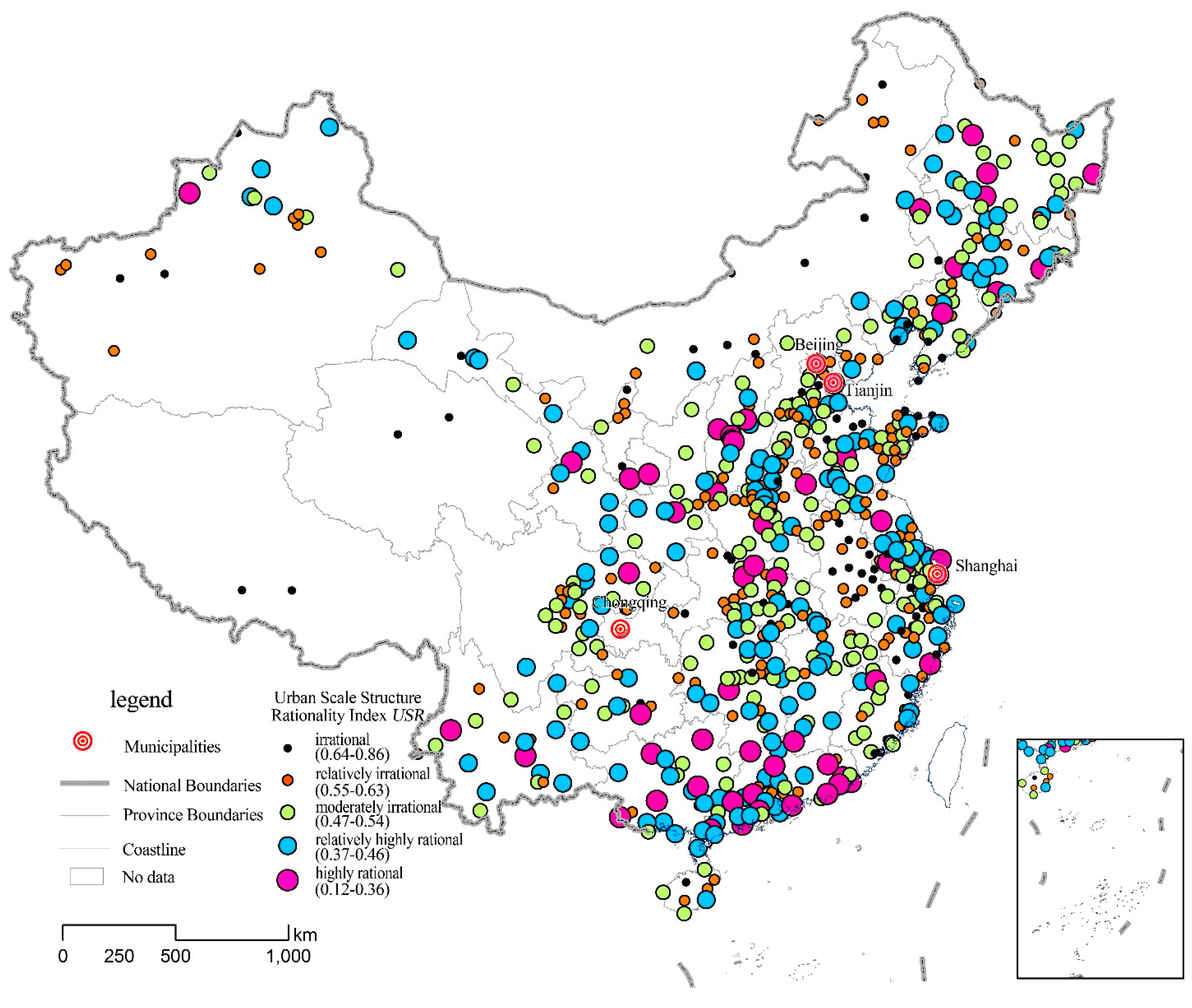
4.2. Rationality Diagnosis of Chinese Urban Space Structure
4.2.1. Kernel Density Analysis of Chinese Urban Space Structure

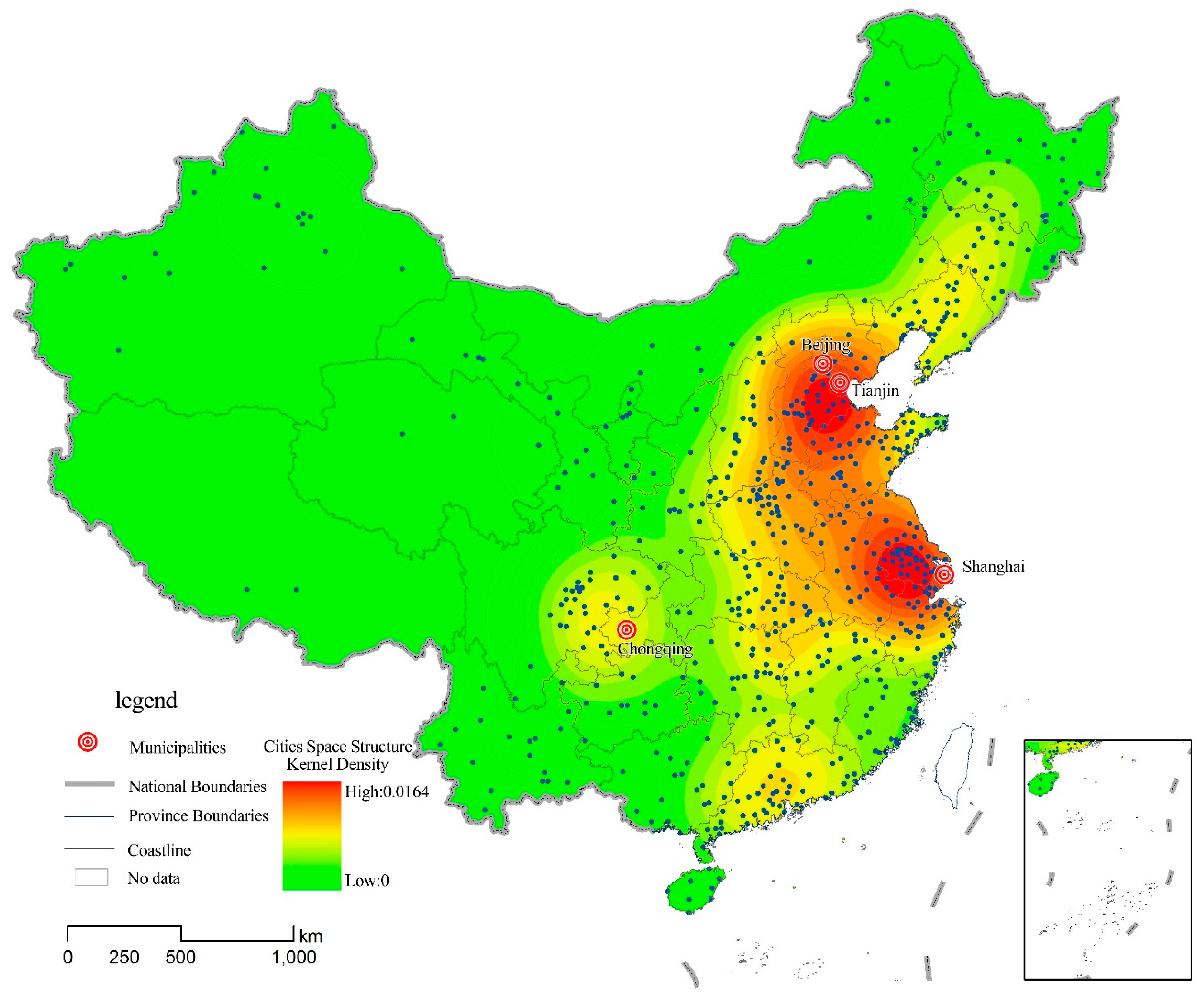
4.2.2. Rationality Diagnosis of Chinese Urban Spatial Structure
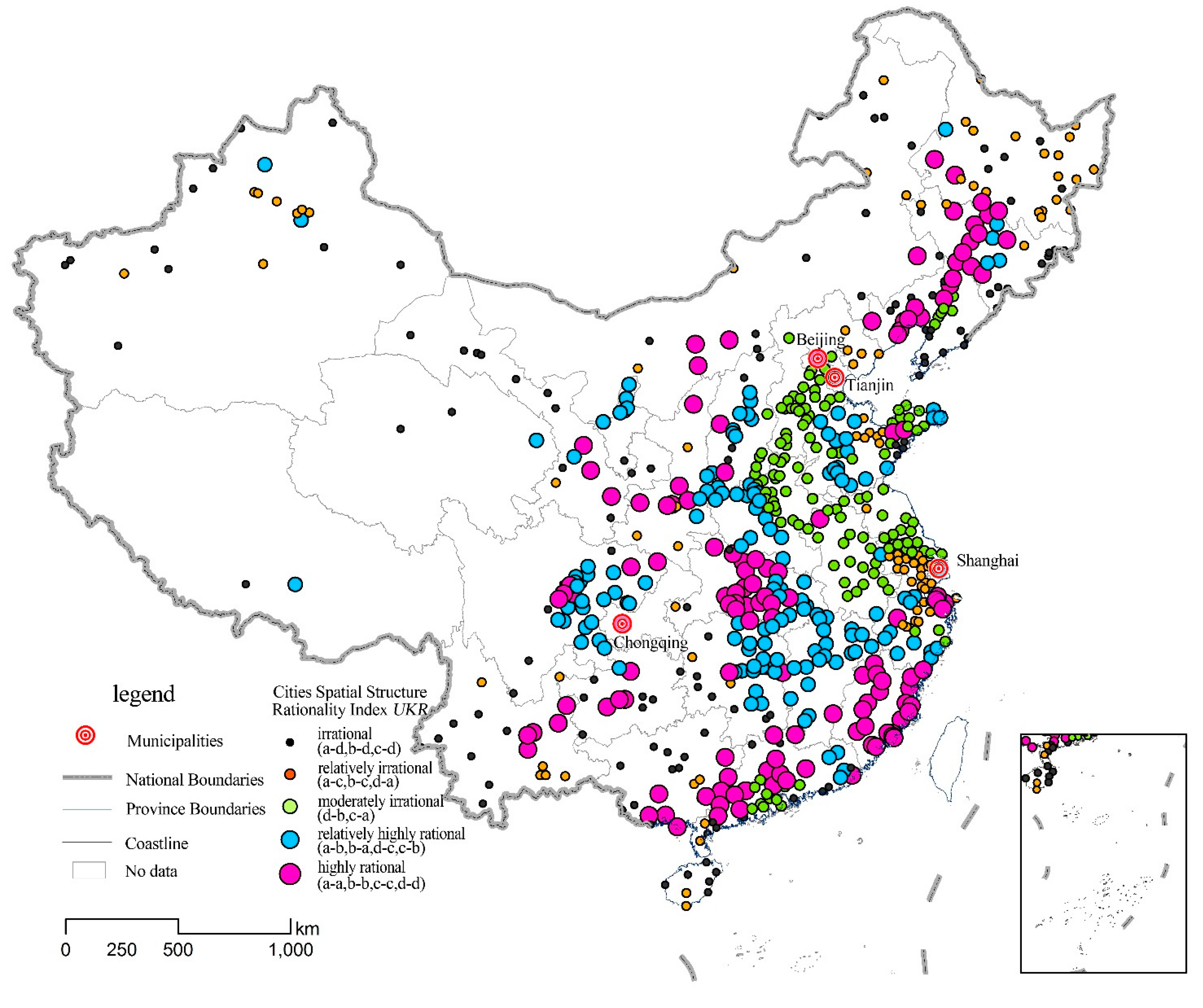
4.3. Rationality Diagnosis of Chinese Urban Functional Structure
4.3.1. Rationality Analysis of Chinese Urban Functional Scale
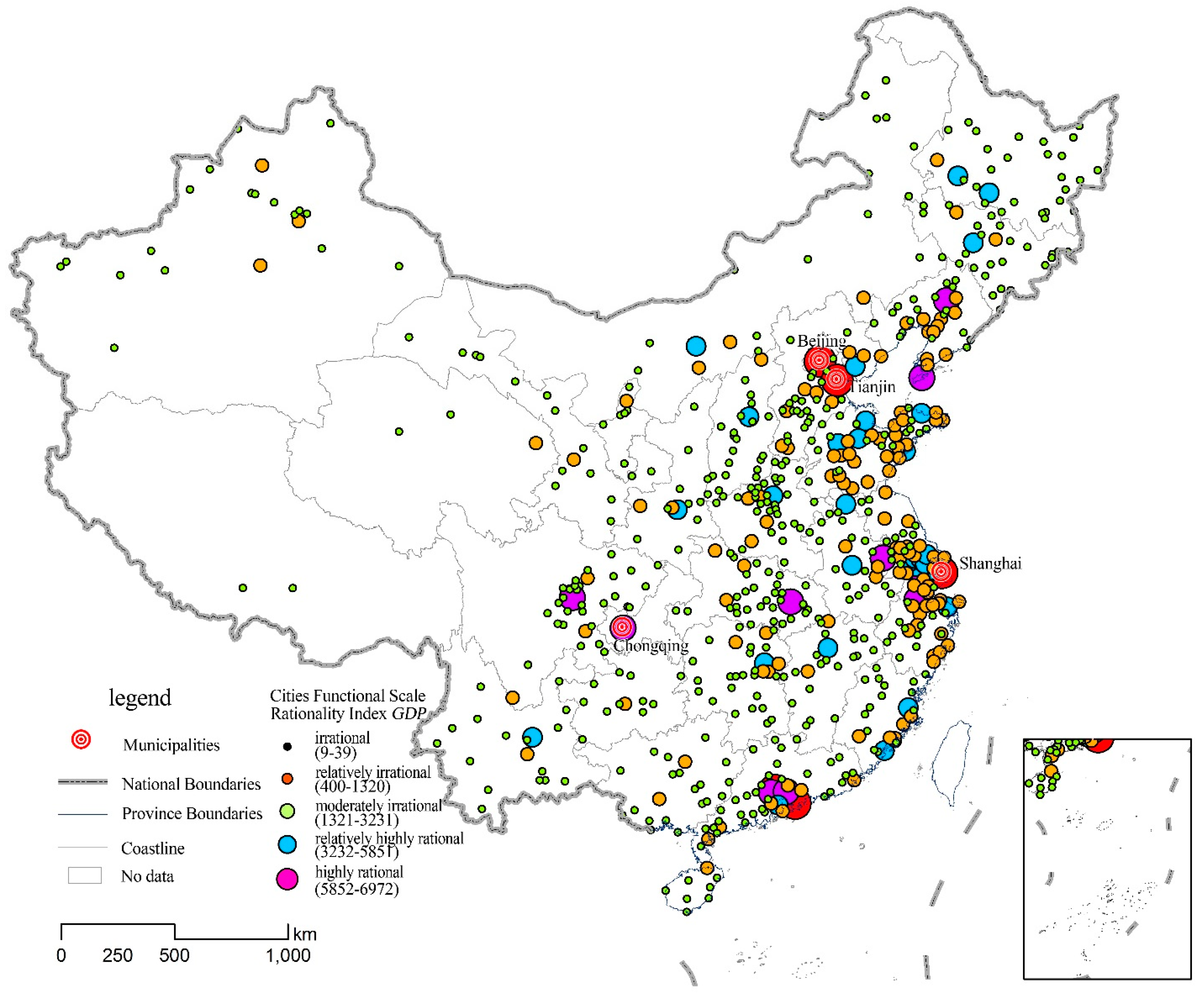
4.3.2. Rationality Analysis of Chinese Urban Functional Intensity

4.3.3. Rationality Analysis of Chinese Urban Diversification
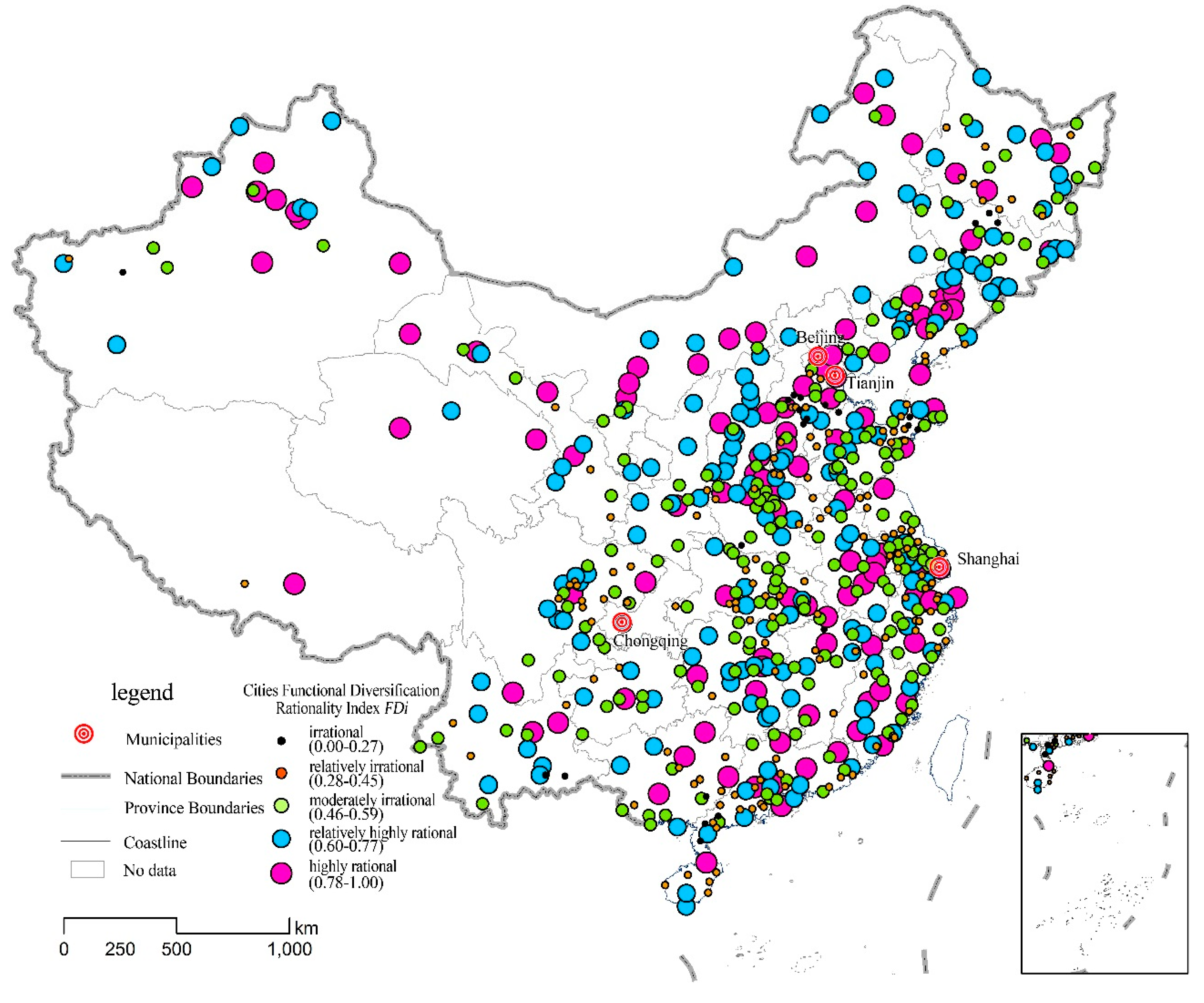
4.3.4. Comprehensive Diagnosis of Chinese Urban Functional Structure Rationality
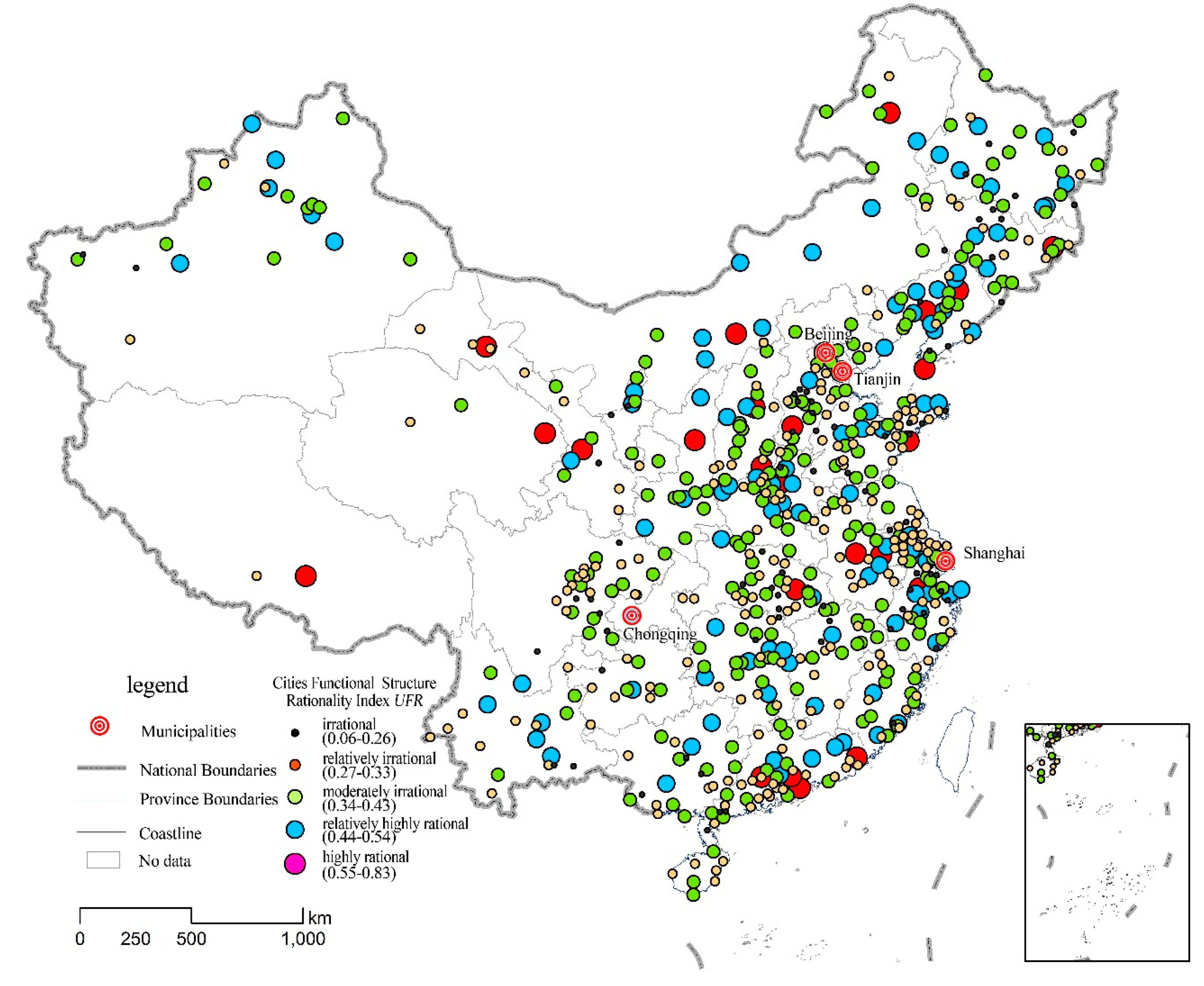
4.4. Comprehensive Diagnosis of Chinese Urban Development Structure Rationality
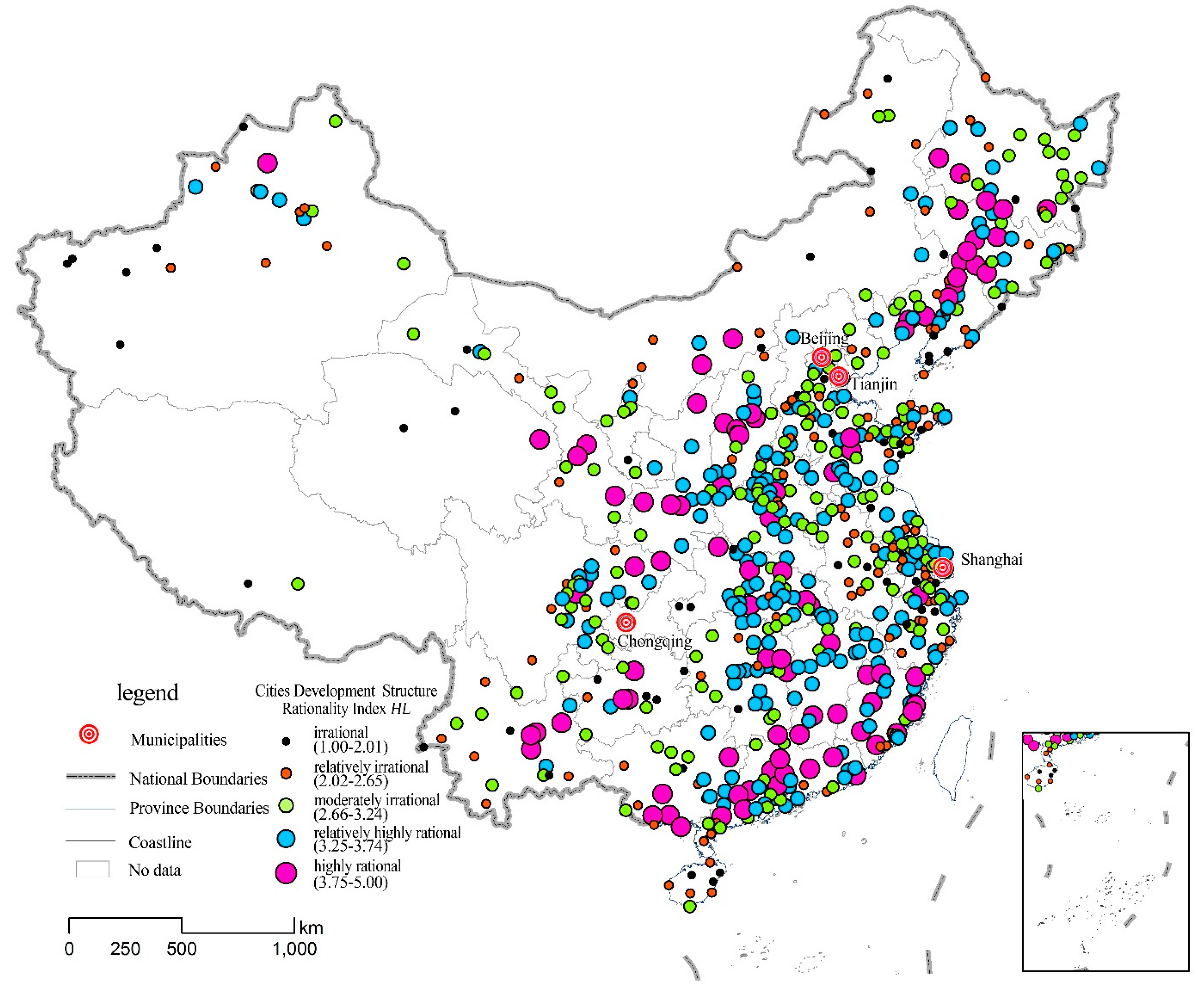
5. Discussion and Conclusions
| Urban rationality Classification | Urban Scale Structure Rationality | Urban Spatial Structure Rationality | Urban Functional Structure Rationality | Urban Development Pattern Rationality | ||||
|---|---|---|---|---|---|---|---|---|
| Number of cities | Percentage that are rational | Number of cities | Percentage that are rational | Number of cities | Percentage that are rational | Number of cities | Percentage that are rational | |
| Highly rational | 69 | 10.50 | 132 | 20.09 | 62 | 9.44 | 95 | 14.46 |
| Relatively highly rational | 151 | 22.98 | 178 | 27.09 | 175 | 26.64 | 207 | 31.51 |
| Moderately rational | 227 | 34.55 | 146 | 22.22 | 217 | 33.03 | 163 | 24.81 |
| Relatively irrational | 150 | 22.83 | 77 | 11.72 | 139 | 21.16 | 134 | 20.40 |
| Irrational | 60 | 9.14 | 124 | 18.87 | 64 | 9.74 | 58 | 8.83 |
| Total | 657 | 100.0 | 657 | 100.0 | 657 | 100.0 | 657 | 100.0 |
Acknowledgments
Author Contributions
Conflicts of Interest
References
- Liu, X.J.; Derudder, B.; Taylor, P. Mapping the evolution of hierarchical and regional tendencies in the world city network, 2000–2010. Comput. Environ. Urban Syst. 2014, 43, 51–66. [Google Scholar] [CrossRef]
- Chen, X.; Greene, R.P. The spatial-temporal dynamics of China’s changing urban hierarchy: 1950–2005. Urban Stud. Res. 2012, 2012. Article 162965. [Google Scholar] [CrossRef]
- Myint, S.W. An exploration of spatial dispersion, pattern, and association of socio-economic functional units in an urban system. Appl. Geogr. 2008, 28, 168–188. [Google Scholar] [CrossRef]
- Baccaini, B.; Pumain, D. Migrations in the French Urban System, 1982–1990. Population 1998, 53, 947–977. [Google Scholar] [CrossRef]
- Esparza, A.X.; Krmenec, A.J. Large city interaction in the US urban system. Urban Stud. 2000, 37, 691–709. [Google Scholar] [CrossRef]
- Osada, S. The Japanese urban system 1970–1990. Prog. Plan. 2003, 59, 125–231. [Google Scholar] [CrossRef]
- Zook, M.; Devriendt, L.; Dodge, M. Cyber spatial proximity metrics: Reconceptualizing distance in the global urban system. J. Urban Technol. 2011, 18, 93–114. [Google Scholar] [CrossRef]
- Utrilla, S.E. Recent Dynamics of the Chilean Urban System 1970–2002: Integration at a National Level. Boletin De La Asociacion De Geografos Espanoles 2012, 59, 129–150. [Google Scholar]
- Pogacnik, A. Proposal of changes in the urban system of Slovenia. Geodetski Vestnik 2013, 57, 97–111. [Google Scholar] [CrossRef]
- Tellier, L.N. Projecting the topodynamic evolution of the West-African urban system: Is West Africa heading for an “urbexplosion” or an “urbimplosion”? Can. J. Dev. Stud. 1996, 17, 405–426. [Google Scholar] [CrossRef]
- Robson, B.T. Growth-Centers in the European Urban System—Hall,p, Hay,d. Geogr. J. 1983, 149, 89–91. [Google Scholar]
- Shin, K.H.; Timberlake, M. World cities in Asia: cliques, centrality and connectedness. Urban Stud. 2000, 37, 2257–2285. [Google Scholar] [CrossRef]
- Gu, C.L.; Guan, W.H. Approach to urban system dynamic in China. In Proceedings of the 2005 Conference of System Dynamics and Management Science-Sustainable Development of Asia Pacific, Shanghai, China, 4–6 November 2005; pp. 193–196.
- Limtanakool, N.; Schwanen, T.; Dijst, M. Developments in the Dutch urban system on the basis of flows. Reg. Stud. 2009, 43, 179–196. [Google Scholar] [CrossRef]
- Coffey, W.J.; Shearmur, R.G. The growth and location of high order services in the Canadian urban system, 1971–1991. Prof. Geogr. 1997, 49, 404–418. [Google Scholar] [CrossRef]
- O'Donoghue, D. The relationship between diversification and growth: Some evidence from the British urban system 1978 to 1991. Int. J. Urban Reg. Res. 1999, 23, 549–566. [Google Scholar] [CrossRef]
- Agnew, J. The Italian urban system: Towards European integration. Urban Stud. 2000, 37, 1215–1217. [Google Scholar]
- Johnston, R.; Poulsen, M.; Forrest, J. Ethnic residential segregation across an urban system: The Maori in New Zealand, 1991–2001. Prof. Geogr. 2005, 57, 115–129. [Google Scholar] [CrossRef]
- Tonts, M.; Taylor, M. Corporate location, concentration and performance: Large company headquarters in the Australian urban system. Urban stud. 2010, 47, 2641–2664. [Google Scholar] [CrossRef]
- Ante, U. Areas of the Knowledge Economy—Implocationf for the German urban system. Plan. Rev. 2011, 47, 91–92. [Google Scholar]
- Cladera, J.R.; Bergada, M.M.; Ramos, B.A. The urban system in Spain. Scripta Nova-Revista Electronica De Geografia Y Ciencias Sociales 2012, 16, 1–20. [Google Scholar]
- Ma, X.L.; Timberlake, M. World city typologies and national city system deterritorialisation: USA, China and Japan. Urban Stud. 2013, 50, 255–275. [Google Scholar] [CrossRef]
- Zhou, S.Y.; Dai, J.C.; Bu, J.H. City size distributions in China 1949 to 2010 and the impacts of government policies. Cities. 2013, 32, S51–S57. [Google Scholar] [CrossRef]
- Xu, Z.L.; Zhu, N. City size distribution in China: Are large cities dominant? Urban Stud. 2009, 43, 2159–2185. [Google Scholar]
- Song, S.F.; Zhang, K.H. Urbanisation and city size distribution in China. Urban Stud. 2002, 39, 2317–2327. [Google Scholar] [CrossRef]
- Luckstead, J.; Devadoss, S. A comparison of city size distributions for China and India from 1950 to 2010. Econ. Lett. 2014, 124, 290–295. [Google Scholar] [CrossRef]
- Xu, X.L.; Min, X.B. Quantifying spatiotemporal structures of urban expansion in China using remote sensing data. Cities. 2013, 35, 104–113. [Google Scholar] [CrossRef]
- Liu, J.; Zhang, Q.; Hu, Y. Regional differences of China’s urban expansion from late 20th to early 21st century based on remote sensing information. Chin. Geogr. Sci. 2012, 22, 1–14. [Google Scholar] [CrossRef]
- Tian, G.J.; Liu, J.Y.; Zhang, Z.X. Urban functional structure characteristics and transformation in China. Cities. 2002, 19, 243–248. [Google Scholar] [CrossRef]
- Zhou, Y.X.; Bradshaw, R. The classification of industrial function of Chinese (including attached counties): Theory, method and results. Acta Geogr. Sin. 1988, 43, 287–298. [Google Scholar]
- The State Council. National Major Function Zoning; The State Council Article No. 46 in 2010; The State Council: Beijing, China, 2010. (In Chinese) [Google Scholar]
- Zipf, G.K. Human Behaviour and the Principle of Least Effort; Addison-Wesley: Cambridge, MA, USA, 1949. [Google Scholar]
- Sheather, S.J. Density estimation. Stat. Sci. 2004, 19, 588–597. [Google Scholar] [CrossRef]
- Lu, S.S.; Guan, X.L.; Wang, Z.B.; Song, C. Spatial field of the Yangtze River Delta Economic Zone: An application of regional accessibility and data field. Geogr. Res. 2013, 32, 295–306. [Google Scholar]
- Wang, B.; Zheng, Q.H.; Guo, H. Economic Value Assessment of Forest Species Diversity Conservation in China Based on the Shannon-Wiener Index. For. Res. 2008, 21, 268–274. [Google Scholar]
© 2015 by the authors; licensee MDPI, Basel, Switzerland. This article is an open access article distributed under the terms and conditions of the Creative Commons Attribution license (http://creativecommons.org/licenses/by/4.0/).
Share and Cite
Fang, C.; Wang, Z. Quantitative Diagnoses and Comprehensive Evaluations of the Rationality of Chinese Urban Development Patterns. Sustainability 2015, 7, 3859-3884. https://doi.org/10.3390/su7043859
Fang C, Wang Z. Quantitative Diagnoses and Comprehensive Evaluations of the Rationality of Chinese Urban Development Patterns. Sustainability. 2015; 7(4):3859-3884. https://doi.org/10.3390/su7043859
Chicago/Turabian StyleFang, Chuanglin, and Zhenbo Wang. 2015. "Quantitative Diagnoses and Comprehensive Evaluations of the Rationality of Chinese Urban Development Patterns" Sustainability 7, no. 4: 3859-3884. https://doi.org/10.3390/su7043859
APA StyleFang, C., & Wang, Z. (2015). Quantitative Diagnoses and Comprehensive Evaluations of the Rationality of Chinese Urban Development Patterns. Sustainability, 7(4), 3859-3884. https://doi.org/10.3390/su7043859







